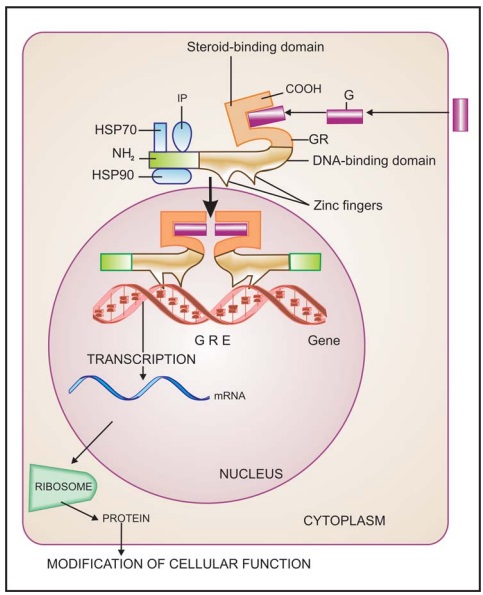Receptors Regulating Gene Expression (Transcription Factors)
| Home | | Pharmacology |Chapter: Essential pharmacology : Pharmacodynamics Mechanism Of Drug Action; Receptor Pharmacology
In contrast to the other 3 classes of receptors, these are intracellular (cytoplasmic or nuclear) soluble proteins which respond to lipid soluble chemical messengers that penetrate the cell.
RECEPTORS
REGULATING GENE EXPRESSION (TRANSCRIPTION FACTORS)
In contrast to the above 3 classes of receptors, these are intracellular (cytoplasmic or nuclear) soluble proteins which respond to lipid soluble chemical messengers that penetrate the cell (Fig. 4.9). The receptor protein (specific for each hormone/ regulator) is inherently capable of binding to specific genes, but is kept inhibited till the hormone binds near its carboxy terminus and exposes the DNA binding regulatory segment located in the middle of the molecule. Attachment of the receptor protein to the genes facilitates their expression so that specific mRNA is synthesized on the template of the gene. This mRNA moves to the ribosomes and directs synthesis of specific proteins which regulate the activity of target cells.


All steroidal hormones (glucocorticoids, mineralocorticoids, androgens, estrogens, progesterone), thyroxine, vit D and vit A function in this manner. Different steroidal hormones affect different target cells and produce different effects because each one binds to its own receptor and directs a unique pattern of synthesis of specific proteins. The specificity as to which hormone will be bound is provided by the hormone binding domain, while that as to which gene will be activated or repressed is a function of the DNA binding/Nterminus domain. Chimeric receptors have been produced which respond to one hormone, but produce the effects of the other hormone.
This transduction mechanism is the slowest in its time course of action (takes hours).
Receptor Regulation
Receptors exist in a dynamic state; their density and efficacy is subject to regulation by the level of on going activity, feedback from their own signal output and other physio-pathological influences. In tonically active systems, prolonged deprivation of the agonist (by denervation or continued use of an antagonist or a drug which reduces input) results in super sensitivity of the receptor as well as the effector system to the agonist. This has clinical relevance in clonidine/CNS depressant/ opioid withdrawal syndromes, sudden discontinuation of propranolol in angina pectoris, etc. The mechanisms involved may be unmasking of receptors or their proliferation (up regulation) or accentuation of signal amplification by the transducer.
Conversely, continued/intense receptor stimulation causes desensitization or refractoriness: the receptor becomes less sensitive to the agonist. This can be easily demonstrated experimentally (Fig. 4.10); clinical examples are bronchial asthma patients treated continuously with β adrenergic agonists and parkinsonian patients treated with high doses of levodopa. The changes may be brought about by:

i) Masking or internalization of the receptor (it becomes inaccessible to the agonist). In this case refractoriness develops as well as fades quickly.
In the case of β adrenergic receptor, it has been found that agonist binding promotes phosphorylation of its serine residues near the intracellular carboxy terminus by an enzyme β adrenergic receptor kinase (βARK), allowing it to bind a protein called βarrestin which hinders its interaction with Gs → receptor transduction is impaired. When the βagonist is removed, the serine residues are dephosphorylated and receptor mediated activation of Gs is restored.
ii) Decreased synthesis/increased destruction of the receptor (down regulation): refractoriness develops over weeks or months and recedes slowly. Receptor down regulation is particularly exhibited by the tyrosine protein kinase receptors.
Some times response to all agonists which act through different receptors but produce the same overt effect (e.g. histamine and acetylcholine both contract intestinal smooth muscle) is decreased by exposure to any one of these agonists (heterologous desensitization), showing that mechanisms of response effectuation have become less efficient. However, often desensitization is limited to agonists of the receptor being repeatedly activated (homologous desensitization).
Both homologous and heterologous desensitization has been observed in the case of GPCRs. The BARKβ arrestin mechanism described above produces homologous desensitization. The GPCRs transduce many responses by activating PKA and PKC. These kinases phosphorylate the GPCRs as well rather non-selectively (at a site different from that of BARK) and hinder their interaction with G-proteins, resulting in heterologous desensitization.
Related Topics
